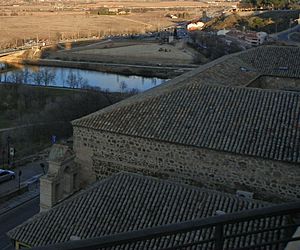Alhóndiga (Toledo) facts for kids
The Alhóndiga of Toledo, Spain, is an old building that dates back to the early 1600s. It's a special kind of building called an "alhóndiga."
In the past, alhóndigas were like inns and marketplaces, especially in their Islamic origins. But by the 1500s, they mostly became places just for storing and selling wheat. Over time, they turned into official centers for the city.
The very first building was constructed between 1575 and 1582. Sadly, it completely fell down in 1593.
After that, in 1594, a person named Nicolás de Vergara el Mozo designed a way to support the ground nearby. Then, the Alhóndiga was rebuilt, and this new construction was finished in 1636.
Throughout its history, the Alhóndiga has been used for many different things. It was a French military warehouse during a war, and more recently, it even served as a bus station!
Contents
What Does the Alhóndiga Look Like?
The Alhóndiga is a rectangular building. It's designed to be simple and very practical, especially for storing grain. This means it doesn't have many windows or openings to the outside.
Inside the Building
Inside, you'll find strong pillars that are shaped like a cross. These pillars are made from small, round stones at their bottom. They help divide the inside of the building into several long sections. The walls inside are painted white.
Outside the Building
On the outside, the building has a stone base. Above this, the walls are built using a mix of brick and stone. The stone parts are arranged like uniform boxes within the walls.
Special Front Entrances
In 1960, two special front entrances were added to the building. These came from an old convent in Toledo called the "Trinitarios Calzados." These entrances are in a style called Plateresque, which is very decorative. One of them has a triangular shape above its doorway. Both entrances feature the cross symbol of the Trinitarian Order.
See also
 In Spanish: La Alhóndiga (Toledo) para niños
In Spanish: La Alhóndiga (Toledo) para niños


